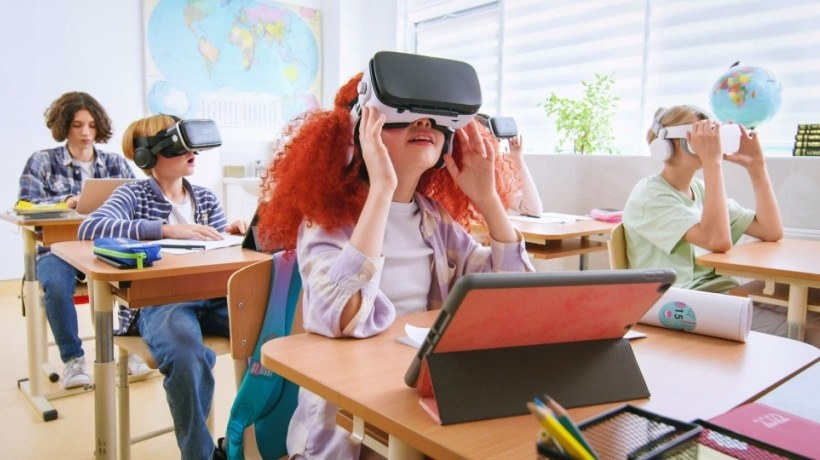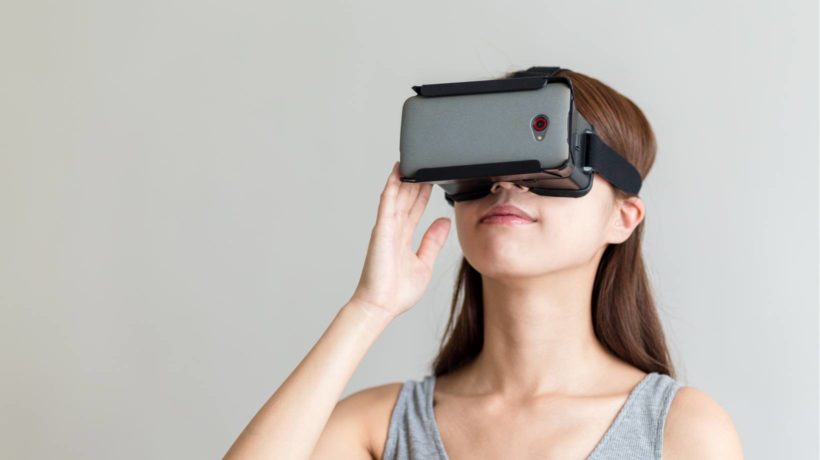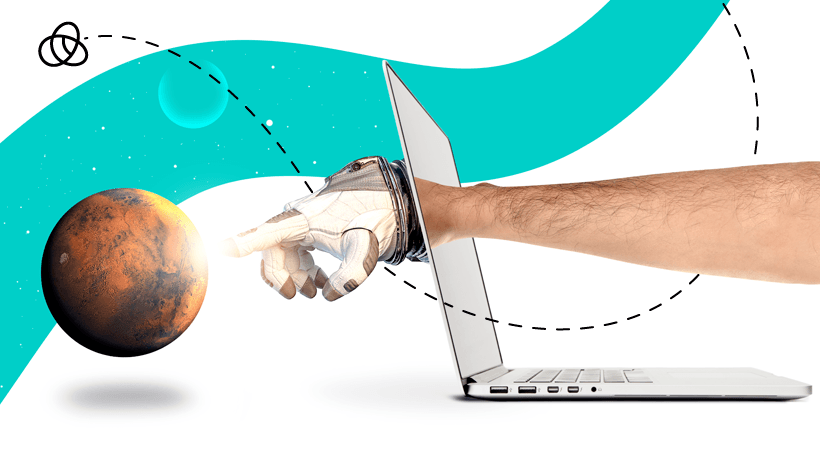The Role Of Immersive Technologies In eLearning
Immersive technologies are changing how people learn. In eLearning, immersive technology includes all the tools and experiences that go beyond screens and static content. You may think of Virtual and Augmented Reality (VR/AR), and you're right, but there are many more, such as Mixed Reality (MR) or AI-driven simulations. All these technologies pull learners into interactive, 3D environments where they can practice, explore, and engage with material in a real way. Instead of just reading a textbook or watching a video, learners can walk through a virtual factory, handle a digital version of machinery, or practice skills like negotiation or public speaking with realistic avatars.
This change is significant. For learners, training becomes more engaging and memorable because they actively participate instead of just absorbing information. This causes retention rates to improve as the brain remembers experiences better than text. Immersive environments also allow learners to try and make mistakes without real-life risks or costs. For example, medical students can practice surgery without harming a patient, and new hires can explore a company's workflow before using actual equipment. So, we could say that immersive technology connects theory with practice in a way that traditional eLearning cannot.
Organizations also benefit greatly. Instead of spending money on training costs such as facilities and transportation, they can offer virtual training that works for teams anywhere. This saves costs and ensures consistent training. Additionally, with AI and analytics in these platforms, companies can collect valuable data on learner interactions, highlight strengths, and identify areas where employees need help. This information helps improve training programs and build stronger workforce skills. Overall, immersive technologies are more than just trends. They show how education and professional training are always improving to deliver and create experiences that are more engaging and effective. Let's explore some popular immersive tech in eLearning, as well as what you should consider before implementing it.
6 Key Immersive Tech Trends In eLearning
1. Virtual And Augmented Reality
Virtual Reality and Augmented Reality make learning more engaging by turning abstract ideas into hands-on experiences. With VR, learners can enter immersive environments, not just basic simulations. For example, they can wear a headset and walk into a virtual chemistry lab, where they can experiment without any risk. This gives them a safe space to practice making decisions under pressure. AR, on the other hand, adds digital elements to the real world, making learning interactive in a unique way. Instead of reading from textbooks, students can explore AR holograms that bring historical events, scientific models, or even machines to life right on their desks. AR also promotes teamwork by allowing groups to build and change 3D models together in real time, connecting classroom lessons to real-world applications.
Both technologies provide great benefits. VR allows learners to practice real-life skills without risks, while AR makes information easier to understand by blending digital world elements in the physical world, turning eLearning into a more immersive, interactive, and memorable experience than traditional methods.
2. Metaverse Learning Ecosystems
What if students could log into a virtual campus and walk into a digital classroom as their avatars? There, they can greet classmates, chat with their instructor, and sit at a virtual desk, all from home. This is what metaverse learning ecosystems do; they offer shared virtual worlds made for education and training. They can have lecture halls, lounges, and collaboration rooms where learners can brainstorm and build projects together in real time. The best part is that when students log off, their avatars, projects, and conversations stay in the metaverse. This allows them to return to them anytime. The scenario isn't far-fetched. Some universities have set up virtual campuses where students attend lectures, join clubs, and socialize online. Companies are trying out training metaverses too, where new employees can explore a digital version of their office, meet mentors, and complete onboarding tasks in an interactive way.
The metaverse encourages social learning, giving learners a sense of community that is often missing in online courses. It also provides continuity, since no matter where you are, you can log in and continue right where you left off. Additionally, it connects people from different countries and cultures, which traditional classrooms typically can't.
3. Mixed And Extended Reality
We spoke about how Virtual Reality takes you into a completely digital world, while Augmented Reality adds digital elements to the real world. Mixed Reality, though, combines the two. It lets digital and physical objects exist and interact with each other in real time. Now, Extended Reality (XR) is the overall term that includes VR, AR, and MR. For instance, imagine engineers from different countries who are all wearing MR headsets and can view and interact with the same 3D model of a new product as if it's in front of them. Similarly, in a classroom, a biology teacher could project a human heart into the room, enhancing the physical classroom with interactive digital experiences that make complex ideas easier to understand.
The true power of MR and XR is their ability to teach skills that are hard to learn from slides or textbooks. Thanks to these technologies, technical training is safer and more engaging. Additionally, remote collaboration is more possible and easier than ever. In short, MR and XR let people do, explore, and collaborate as if the digital and physical worlds were one seamless space.
4. AI And Immersive Tech
By combining AI and immersive tech in eLearning, students can enter a virtual classroom and meet an avatar that understands how they learn. This will be their personal digital tutor. Instead of everyone taking the same course, AI-driven avatars can act as their tutors and adjust to their pace, explain things differently if someone's struggling, and offer extra challenges when learners are ready to advance. This offers plenty of opportunities for real-time performance analysis, too. For example, if someone is training for sales in VR, the system tracks their tone, body language, and how confidently they speak. They also receive feedback right in that moment.
The exciting part of combining AI and immersive technology is the chance to create personalized learning paths. If someone learns a skill quickly, the system moves them ahead. If they need more time, it slows down and offers extra practice. This way, learners stay motivated because their journey feels designed for them.
5. Gamification And Storytelling
When you think of learning, you might picture textbooks, slides, or quizzes. But what if learning felt like playing a game or being part of a story? That's what gamification and storytelling do in immersive environments, changing how people engage with eLearning. Gamified platforms work like mobile games. Learners earn points for completing tasks, rank in leaderboards for friendly competition, and unlock digital badges to show their progress. Storytelling adds to this experience. Instead of just watching content, learners take part in a narrative they can influence. For instance, an employee practicing leadership skills in a VR simulation can take part in a story where they have to make tough choices that affect their team.
When gamification and storytelling work together, learners stay motivated and practice problem-solving, especially when they collaborate with their peers. Teams tackle challenges as characters in a shared story, building both knowledge and teamwork skills.
6. Brain-Computer Interfaces And Neuroadaptive Learning
Brain-Computer Interfaces (BCIs) are systems that connect our brains directly to digital platforms, using tiny sensors to pick up brain activity. While this might sound like something out of a sci-fi movie, the technology is already in the early stages of development and has the potential to completely transform eLearning. Here's how it works: A BCI device can detect signals that reveal things like cognitive load, which is how much mental effort learners are using, stress levels, or whether they're fully focused. So, if someone's brain is overloaded while in an immersive training session, the system notices. Then, instead of pushing them harder, the environment could automatically slow down, repeat key points, or simplify the task until learners are ready to move forward. On the other hand, if the system sees that a learner finds things too easy, it could make the challenge harder to keep them engaged.
This is called "neuroadaptive learning." It is revolutionary because it means the training experience literally adapts to our brains in real time. The potential benefits are huge: learners stay motivated instead of frustrated, companies reduce wasted training time, and educators can ensure no one gets left behind. While we're still in the early days, BCI-driven learning could eventually create classrooms and training programs that are truly inclusive.
Conclusion
Immersive technologies are changing the way we learn, making education more engaging, memorable, and practical. When learners can interact with realistic simulations, explore virtual environments, or practice skills hands-on, they stay focused longer and remember more. Plus, it promotes real-world application that prepares people for actual challenges. For organizations and educators, embracing immersive tech isn't optional anymore. Those who invest in VR, AR, and other immersive tech in eLearning will empower their learners and boost their outcomes.









